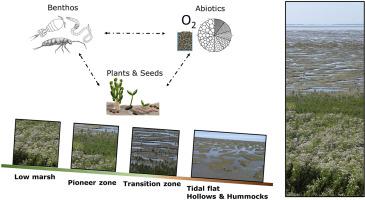Estuarine, Coastal and Shelf Science ( IF 2.6 ) Pub Date : 2020-07-21 , DOI: 10.1016/j.ecss.2020.106909 M. van Regteren , D. Amptmeijer , A.V. de Groot , M.J. Baptist , K. Elschot

|
Salt marshes are vegetated ecosystems between land and sea, hosting unique plant and animal communities, contributing to crucial habitats for birds and providing numerous other ecosystem services. They form a sustainable nature-based coastal protection, and its protective value increases with the width of the system. Salt marshes and their adjoining tidal flats are often studied separately. At present, there is a lack of studies that describe the features of these two systems in unison and in relation to each other. This study descriptively assesses an array of abiotic and biotic variables that potentially affect successful vegetation establishment. Unfavourable soil conditions may limit establishment as well as bioturbation of infauna. This is related to the marsh expansion potential and could aid in salt marsh restoration and marsh growth stimulation projects. In a naturally developing salt marsh, we sampled the elevation gradient from the tidal flat to the low marsh for benthic species composition, plant seed availability and abiotic variables. The abundance of benthos was highest landwards of the transition zone, in the pioneer zone. Distinct meiobenthic groups occurred in the different zones along the tidal flat to low marsh gradient, but macrobenthos was largely absent from the muddy soil. In the sparsely vegetated transition zone, the abundance of salt-marsh seeds was low, similar to the tidal flat. It suggests that, even though a seed source was in proximity, seed availability in spring was insufficient to achieve lateral marsh expansion. Clustering and nMDS analyses showed that an identifiable transition zone was lacking. The transition zone resembled the bare tidal flat in terms of its abiotic and biotic conditions. This was mainly driven by significant changes in soil oxygenation and seed availability.
中文翻译:

盐沼从哪里开始?基于实地的证据,表明潮间带逐渐倾斜的滩涂和盐沼之间没有过渡区域
盐沼是陆地和海洋之间的植被生态系统,拥有独特的动植物群落,为鸟类的重要栖息地做出了贡献,并提供了许多其他生态系统服务。它们形成了可持续的,基于自然的沿海保护,其保护价值随系统的宽度而增加。盐沼及其毗邻的滩涂经常被单独研究。当前,缺乏研究来统一和相互描述这两个系统的特征。这项研究描述性地评估了可能影响成功植被建立的一系列非生物和生物变量。不利的土壤条件可能会限制基础设施的建立和生物扰动。这与沼泽的扩展潜力有关,并可能有助于盐沼的恢复和沼泽生长的刺激项目。在自然发育的盐沼中,我们对从滩涂到低沼泽的海拔梯度进行了采样,以获取底栖物种组成,植物种子的可利用性和非生物变量。底栖动物的丰富度是过渡区最高的陆上区域,处于先驱区。沿潮滩至低沼泽梯度的不同区域出现了明显的中底栖动物群,但在泥泞的土壤中基本上没有大型底栖动物。在稀疏的过渡带,盐沼种子的丰度很低,类似于潮滩。这表明,即使附近有种子源,春季的种子供应也不足以实现横向沼泽扩展。聚类和nMDS分析表明,缺少可识别的过渡区。就非生物和生物条件而言,过渡区类似于裸潮滩。这主要是由土壤氧合作用和种子供应量的显着变化驱动的。











































 京公网安备 11010802027423号
京公网安备 11010802027423号